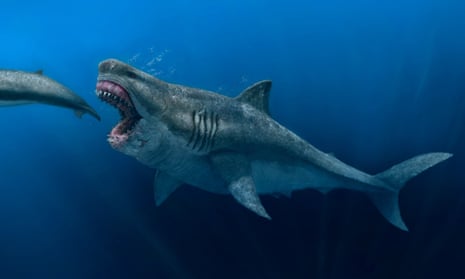Huge, fearsome and boasting an enormous pair of jaws, the star of Hollywood’s The Meg left even the movie hardman Jason Statham troubled by its size.
Now researchers say the gigantic prehistoric shark megalodon might have been slimmer than previously thought.
Scientists say past reconstructions of the extinct beast, also known as the megatooth shark, were flawed because they drew on an assumption that its body form resembled a larger version of the great white shark, the planet’s largest living predatory fish.
Instead, the team say a new analysis of measurements from an incomplete set of megalodon fossil vertebrae suggests it looked rather different, with a longer and more slender body.
“Our study suggests that the modern great white shark may not necessarily serve as a good modern analogue for assessing at least certain aspects of its biology, including its size,” said Prof Kenshu Shimada, a palaeobiologist at DePaul University in Chicago and the senior author of the study.
But, he added: “The reality is that we need the discovery of at least one complete megalodon skeleton to be more confident about its true size as well its body form.”
Writing in the journal Palaeontologia Electronica, Shimada and his colleagues report how an earlier study recorded the measured vertebral column of an incomplete megalodon fossil to be 11.1 metres in length. Other work, however, suggested the length of the same fossil, estimated from the proportions of the great white, was 9.2 metres.
Among other concerns, the team note that in some cases a juvenile great white was used as a model for megalodon, while there are also discrepancies between the ratio of the length of the jaw to the vertebrae for the two species.
Together with recent research, including estimates of the cruising speeds of the prehistoric behemoth, the team conclude it is a mistake to model the body form of megalodon on the proportions of the great white and that analysis suggests the prehistoric beast was more elongated.
“However, the slender body would indicate that megalodon may not have been a powerful swimmer as much as the modern great white shark is,” said Shimada, adding the observation was consistent with his recent study suggesting megalodon may have been a slow-cruising shark with occasional “burst swimming” for capturing prey.
“As one of the largest carnivores that ever existed, deciphering the biology of megalodon is critical to understand the role large carnivores play in the context of the evolution of marine ecosystems and how its extinction influenced the development of the present-day ocean,” he said.
Prof John Hutchinson of the Royal Veterinary College, who co-authored some of the research the new paper critiques, said his team not only used the proportions of the great white to help reconstruct megalodon’s body form but also drew on the dimensions of other sharks, while the new study does not prove such an approach is inappropriate.
“They don’t falsify our hypothesis, they cast doubt on it,” he said.
Hutchinson added that the new study, paradoxically, also draws on comparisons to the great white’s anatomy, but does not offer alternative estimates for megalodon’s dimensions.
Fundamentally, he said, the work does not change the fact that megalodon was an enormous, fearsome shark. “This was one of the greatest oceanic predators ever,” he said. “It would have been absolutely terrifying.”
Evolving images
Megalodon is not the only prehistoric beast whose image has evolved over time. Here are some others:

Not so fast: With an enormous body, huge teeth and sharp claws, T rex was a fearsome predator. It was not, however, as speedy as films such as Jurassic Park suggest. Research published in 2021 suggests they had a walking pace of just under 3mph, while another study from 2011 puts their top jog at about 25mph.
Size matters: In general, while dinosaurs went big, the mammals that lived alongside them went small. But this was not always the case. Velociraptors were about the size of a turkey, while research has revealed some mammals were as large as a badger or dog.
No pushovers: Some dinosaurs were terrifying meat-eaters, but mammals were not necessarily timid. A recently discovered fossil shows a mammal attacking a dinosaur, while others show the same mammal species with the bones of a baby dinosaur where its stomach would have been, suggesting it had been a meaty snack.
Ruffled feathers: “In the books I read as a kid in the 80s and 90s, dinosaurs were depicted as green, scale-covered brutes, but the discovery of feather-covered dinosaur fossils in China in the mid 1990s showed that many dinosaurs would have looked a lot more like birds,” said Prof Steve Brusatte, a palaeontologist at the University of Edinburgh. “It’s a shocking image change.”
